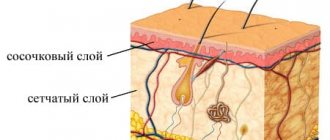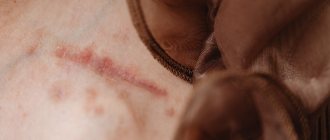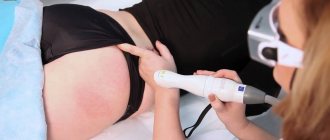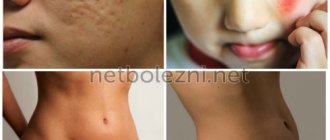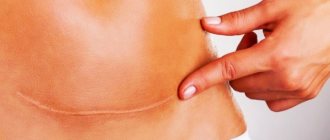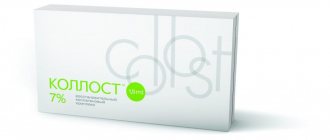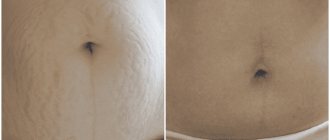An effective and even indispensable means of solving this problem is peeling of scars after acne treatment. At all times, even and smooth skin was considered one of the standards of beauty. But for many people, especially fair-haired and fair-skinned people, unpleasant formations in the form of acne (pimples and acne) can be so strong that even after getting rid of them, the skin cannot return to its normal state. The pockmarks, pits, and scars from treated acne give it a rough, bumpy, or pockmarked appearance in places.
Naturally, there are several (four in total) types of scars on the skin that appear due to other reasons - from skin damage from injuries and burns. But with cosmetic treatment methods, only two types of scars can be qualitatively smoothed and removed - normotrophic and hypotrophic. In more complex cases, it is already necessary to involve plastic surgery.
Since scars and skin irregularities, which are the insidious consequences of pimples and acne, are normotrophic manifestations, they can be effectively combated with the help of physical or chemical peeling.
What is the difference between a scar and a scar?
From a scientific point of view, both of these concepts mean the same thing:
- In the Russian language there is the word “scar”, which comes from the word “to chop”, which was used to describe marks after wounds, burns, healed ulcers and other skin lesions. Later, this name extended to postoperative tissue changes.
- The word "scar" comes from the German language, where it also means marks on the skin left after an injury.
Scar
Scarring
Therefore, from a medical point of view, there is no difference between these two concepts.
Long gone are the days when scars were considered decoration, especially among the stronger sex. Nowadays, no one wants to have marks on their skin from surgery or injury, which explains the popularity of various methods for removing scar tissue.
Types of scars
Normotrophic scars are most often located at the same level with the skin, they are less noticeable, easiest to correct and differ mainly in shade - they are somewhat lighter than the skin.
Atrophic scars occur after an inflammatory process or injury; they are not as elastic as normal tissues and have a concave surface. A typical example of atrophic scars is stretch marks and post-acne.
Keloid scars can have different shapes; they are elastic, dense, usually with a smooth surface. The appearance of keloid scars can lead to unpleasant sensations: burning, itching, even pain. Typically, such formations protrude above the surface of the skin. They have clear boundaries. Keloid scars can grow and appear again after removal. Most often they form on the outer surface of the shoulder, in the sternum and upper torso. Difficult to correct.
Hypertrophic scars protrude above the surface of the skin. Most often they have a pink tint, and are formed due to the large area and depth of the wound, contamination of the surface or other unfavorable conditions for the healing of damaged tissue. It is mature connective tissue covered by a layer of epidermis. Within six months after its appearance, hyperkeratosis gradually disappears, and the progression of the scar stops.
Surgical excision of the scar
Surgical removal of scar tissue is used for skin tightness at the site of injury or unsightly, uneven, disfiguring scars. During the operation, the surgeon excises the pathological tissue and applies a neat suture.
A thin, smooth scar remains on the face or body, which can then be removed using laser or mechanical resurfacing. Nowadays this technique is rarely used, in the absence of an alternative. Surgical excision has been replaced by methods that make it possible to remove scar tissue without surgery.
Care and recovery
After laser resurfacing, the skin recovers quite quickly. However, in the first few hours after the procedure, redness and discomfort may appear. If they cause you discomfort, you can apply a cooling compress to the treatment area.
For 3 days after the removal procedure, you should not wipe the treated areas of the skin with alcohol-containing substances. It is prohibited to visit the sauna and swimming pool, take a hot bath, or sunbathe.
The skin needs to be moisturized. Or use special medical gels and creams that your doctor will prescribe for you.
Each patient at Cleo Line is given detailed care recommendations after the procedure.
Laser scar removal
Laser procedures make scars and scars invisible and can even get rid of them completely. A good effect is achieved by using a CO2 laser, the beam of which removes the top layer of skin along with scar tissue. As a result, healthy skin forms at the site of the scar.
Laser scar removal before and after
The advantage of a laser beam is its ability to penetrate the skin and subcutaneous tissue to a certain depth and remove scars, leaving virtually no traces. However, those who prefer this method need to remember that after one session the desired effect will not be achieved. And after a long course of procedures, large marks from damage and operations may not disappear completely, but only become less noticeable.
The essence of the procedure
In the first stages, grinding reduces the depth of scar formations. In the future, the scar can be removed almost completely.
Laser resurfacing of facial scars occurs according to the following principle. First, the laser removes the stratum corneum that makes up the scar itself. In the freed area, cells begin to divide intensively, and natural production of collagen and elastin occurs. Thanks to these substances, a new layer of healthy, smooth skin is formed in the scar area. The device has a built-in cooling system, which prevents overheating of the epidermis from laser beams. We are also seeing a significant reduction in recovery time after the procedure.
After laser treatment, thin channels will remain in the skin tissue, where new cells will begin to form over time. Dead skin particles will evaporate through small holes that are formed in the upper skin due to the action of the device. The rest of the skin surface will not be affected by the laser. Its appearance and internal structure will remain the same.
On the face, laser resurfacing even removes scars from sensitive areas such as the eyelids and lips.
Professionals advise visiting a cosmetologist as soon as possible after the damage has healed. Those scars that have been on the skin for less than six months are removed quickly and almost completely. Usually one or two procedures are enough for this. Deep damage requires longer correction.
Using the laser resurfacing method, you will get the following effect:
- smoothing the skin surface;
- changing the color of the scar to a normal healthy shade;
- gradual and complete removal of the scar.
In the photo: a device used for laser resurfacing of scars.
The optimal period for visiting a cosmetologist for a course of procedures is autumn or winter (cold season). It is important that during the recovery stage the skin is protected from sunlight. Immediately after the session, she is irritated by the laser, and ultraviolet light can provoke the formation of dark spots near the scars (due to increased melatonin production).
Laser facial resurfacing should only occur after prior consultation with a cosmetologist. A professional will take into account not only the size and time that the scar is on the skin, but also the characteristics of your body.
Read material on the topic: Removal of warts with laser: technology, consequences, recommendations
Removal of scars using chemical peeling
During this procedure, the dermatologist applies a chemical solution to the area of skin where the scar has formed.
Depending on its composition, the peeling agent can affect only the top layer of the skin - the epidermis or penetrate into its middle layer - the dermis. Very deep procedures are not currently performed due to their traumatic nature and the availability of more gentle alternatives that give the same effect.
After some time of exposure to chemicals, the top layer of skin peels off along with the cells that form the scar. Shallow scars disappear in one or two procedures; in other cases, more sessions are required.
Are there any contraindications and side effects?
Achieving a visually noticeable cosmetic effect requires a procedure in two/three stages. Moreover, the interval between these stages should be from 1 to 3 months (depending on how the skin regeneration proceeds). It is dangerous to use peelings for sensitive and thin skin. Under the influence of acids, her condition can be made even worse. First you need to carefully and accurately do a small test. Checking for allergic reactions before performing a scar removal procedure is also desirable, and even mandatory. All this needs to be clarified before exposing the skin to highly concentrated formulations.
All peels, from the most gentle to the most radical, have a number of contraindications.
Peels for scars: contraindications
Any peeling is a protracted procedure, quite complex, painful and stressful for the body. You should not decide on it when the skin clearly has a tendency to form keloid scars. There is also a certain list of contraindications related to the general condition of the body.
This
- pregnancy and breastfeeding months;
- the presence of benign or malignant tumors;
- heart and vascular diseases, as well as hypertension;
- liver and kidney diseases;
- endocrine disorders and diabetes;
- manifestations of rosacea and rosacea;
- mental illnesses and disorders;
- allergic manifestations to the components of peeling compositions.
Mesotherapy – removal of scars using injections
The introduction of drugs that have a resolving and softening effect makes scars less noticeable, removes the “tightness” effect and smoothes the skin. This technique in its pure form can only be used for shallow scar changes. In other cases, it is combined with other treatments - resurfacing, chemical peeling, dermabrasion, and other methods of removing scar tissue.
Mesotherapy – removal of scars using injections before and after
Preparations used in mesotherapy contain components that trigger the rejuvenation process in the skin. As a result, scar cells are replaced with healthy skin.
Plasmolifting – blood plasma will get rid of scars
During this procedure, blood is taken from a vein from the patient and placed in a centrifuge. There, the liquid yellowish part - plasma and blood cells - platelets are separated from it. This composition is rich in useful substances - vitamins, microelements, enzymes, amino acids, proteins.
Plasma, when introduced into the scar area, causes cell regeneration, stimulating the growth of new cellular structures. The tissues are saturated with nutrients that enhance blood circulation and metabolic processes. Skin cells are renewed, and after the second session of plasma therapy, scars often become less noticeable. To obtain a pronounced effect, you need to do several such procedures, after which the scars will become smaller or disappear completely.
All these procedures can be supplemented with the use of care products - serums, creams, masks that have absorbable and regenerating properties. A dermatologist will help you select such drugs. The procedures performed will not only get rid of scars and scars, but will also significantly improve the appearance of the skin, making it young, beautiful and smooth.
